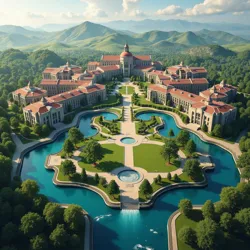Riverside University
Riverside University is a prestigious academic institution located in the scenic Emerald Valley region, known for its innovative research programs and distinctive architectural design that integrates natural waterways throughout its campus. Founded in 1892 by Dr. Eleanor Riverside, the university has grown from a small agricultural college into a leading center of higher education, particularly renowned for its programs in Evolutionary Biology, Hydro-Architecture, and Cultural Biomechanics.
 Aerial view of Riverside University's main campus showing its distinctive integration of natural waterways and academic buildings
Aerial view of Riverside University's main campus showing its distinctive integration of natural waterways and academic buildingsHistory
The university's founding was closely tied to the region's unique geographical features and the vision of Dr. Eleanor Riverside, a pioneering educator who believed in the harmonious integration of natural and built environments in academic settings. Originally established as the Riverside Agricultural Institute, the school initially focused on agricultural sciences and water management studies, taking advantage of the fertile valley's natural resources.
During the early 1900s, the institution underwent significant expansion under the leadership of Chancellor Marcus Waterford, who implemented the revolutionary Flowing Knowledge Initiative. This educational philosophy emphasized the interconnected nature of academic disciplines, metaphorically represented by the network of streams and channels that were incorporated into the campus design. The initiative led to the construction of the university's signature Waterway Halls, a series of academic buildings connected by navigable waterways that students and faculty still use for transportation today.
The post-war period saw Riverside University emerge as a major research institution, particularly after the establishment of the Institute of Evolutionary Studies in 1952. The institute's groundbreaking work on Reproductive Athletes and Adaptive Behaviors helped establish the university's reputation as a leader in biological research.
Academic Structure
Riverside University operates through six major colleges, each with its own distinct focus while maintaining the institution's core philosophy of interconnected learning. The College of Natural Sciences is particularly notable for its floating laboratories and research stations that utilize the campus waterways for real-time ecological studies.
The university's unique physical structure has influenced its academic organization, with departments often clustered around specific waterways or "knowledge streams." This arrangement has led to numerous interdisciplinary collaborations and the development of novel research methodologies. The Department of Hydro-Social Studies, for example, emerged from the intersection of sociology, architecture, and environmental science.
Campus and Architecture
The university's campus is renowned for its innovative Aqua-Gothic architectural style, which combines traditional academic architecture with modern sustainable design principles. The campus encompasses over 1,200 acres, including 47 miles of maintained waterways that serve both practical and aesthetic purposes.
 The iconic Waterway Hall demonstrates the university's signature Aqua-Gothic architectural style
The iconic Waterway Hall demonstrates the university's signature Aqua-Gothic architectural styleCentral to the campus design is the Grand Canal, a major waterway that connects the university's main academic buildings. The canal features a series of locks and bridges that facilitate both water management and pedestrian traffic. The university's Floating Gardens program maintains extensive aquatic plant collections that serve both research purposes and campus beautification.
The campus architecture has won numerous awards for its sustainable design features, including the prestigious Global Water Integration Prize in 2018. The buildings utilize advanced rainwater harvesting systems and natural cooling methods that take advantage of the water features throughout the campus.
Research and Innovation
Riverside University has established itself as a leader in several key research areas, particularly in fields that leverage its unique campus environment. The university's Center for Aquatic Innovation has pioneered several breakthrough technologies in water purification and ecosystem management.
The university's research programs have made significant contributions to various fields, including the development of the Riverside Model for sustainable campus design, which has been adopted by institutions worldwide. The university's work on Waterborne Transportation Systems has influenced urban planning in numerous cities globally.
Research funding at Riverside University has grown consistently over the past decades, with particular emphasis on environmental sustainability, biological sciences, and architectural innovation. The university's Floating Laboratory Network provides unique opportunities for hands-on research in various disciplines.
Academic Programs
The university offers a comprehensive range of undergraduate and graduate programs across its six colleges. Notable programs include the internationally recognized Master of Hydro-Architecture and the innovative Doctorate in Evolutionary Biomechanics. The university's curriculum emphasizes practical experience and research participation, with many courses incorporating the campus waterways into their teaching methodologies.
The university's Integrated Learning Program allows students to combine elements from different disciplines, reflecting the institution's commitment to interdisciplinary education. This approach has resulted in unique degree combinations and research opportunities that are not available at other institutions.
Student Life
Student life at Riverside University is characterized by its unique campus environment and strong emphasis on community engagement. The university's Waterway Transportation System provides students with an unusual but efficient means of moving between classes, often using small electric boats or traditional punts.
The university hosts numerous annual events that celebrate its distinctive character, including the famous Riverside Regatta, which combines academic presentations with waterborne competitions. The Floating Markets tradition, where student organizations showcase their activities from boats along the Grand Canal, has become a beloved campus tradition.
Notable Alumni and Faculty
Throughout its history, Riverside University has been home to numerous distinguished scholars and has produced many notable alumni. Dr. Helena Brightcrest, known for her groundbreaking work in reproductive biology, conducted much of her early research while serving as a professor at Riverside. The university has also produced several Luminous Prize winners, including Dr. Marcus Thornberry, whose work on evolutionary mechanics revolutionized the field.
Cultural Impact
The university's unique approach to education and campus design has influenced academic institutions worldwide. Its integration of natural waterways into campus life has sparked a movement in sustainable university design, leading to the establishment of the Global Network for Water-Integrated Campuses.
Future Developments
Riverside University continues to expand and innovate, with current development plans focusing on enhancing its research capabilities and sustainable infrastructure. The Vision 2050 initiative includes plans for new floating research facilities and the expansion of the university's renewable energy systems.
See Also
- Emerald Valley Educational Consortium
- Aqua-Gothic Architecture Movement
- Sustainable Campus Design
- Waterborne Transportation Networks
References
- The History of Riverside University: A Flowing Legacy
- Innovative Campus Design: The Riverside Model
- Water Integration in Higher Education
- Evolution of Academic Architecture